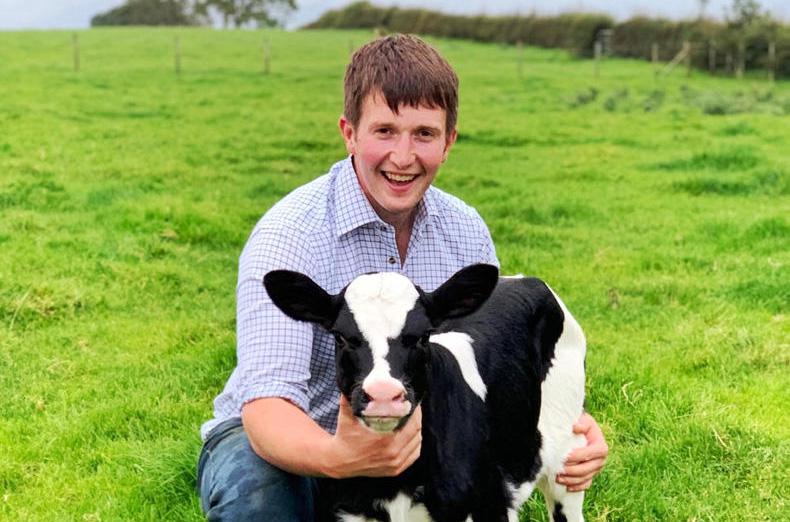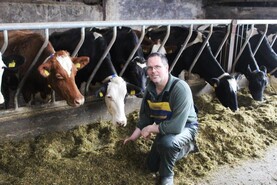A discussion on the subject of dairy crossbreeding can make a heated debate between Trump and Biden look like a tea party. While some view crossbreeding as an economic necessity, others see it as a monstrosity.
In our own situation, using some Fleckvieh genetics in the herd came about primarily to add value to our dairy bull calves, rather than having any wider issues with the Holstein breed.
Since 2012, we have been closed at some point during the calving season with TB, resulting in us rearing a considerable number of Holstein bull calves. These animals never earned enough to justify the effort and capital invested in rearing them, and as a relatively small family farm, it is essential that we maximise income from all enterprises.
Another motivation was the testimony of a neighbouring dairy farmer who is particularly evangelical on the subject of Fleckveih breeding.
After seeing his cows and benchmarking figures (related to breeding) in our dairy business development group, I was convinced that the breed had a great deal of potential. As well as improving calf value in many herds, Fleckvieh crosses also have substantially reduced replacement rates and improved cull cow values.
Breeding Strategy
Our breeding strategy is a follows: I identify the best animals in the herd though milk and health records (I may consider genomically testing heifers in the future), and all of those that are suitable are artificially inseminated with sexed Holstein.
Holstein sires are assigned to cows/heifers using the World Wide Sires mating programme, which helps eliminate inbreeding and corrects cow faults.
Those cows that have the genetic merit to breed dairy offspring, but are unsuited to sexed semen due to age, receive conventional Fleckvieh semen. This enables us to serve them with a dairy sire without the risk of a low-value Holstein bull calf.
An example of a cow mated using this protocol was a fifth-lactation Holstein that had given 13,000 litres in her last lactation. Her first-lactation Fleckveih daughter calved seven weeks ago and is currently giving 42 litres per day.
That leaves cows not suitable for dairy breeding that go to the Aberdeen Angus.
Over the years, I have become extremely selective when it comes to choosing cows to breed dairy replacements from. It is worth remembering that CAFRE benchmarking indicates that the average cost of rearing a dairy heifer is approximately £1,800, so a heifer must have a high level of genetic potential to justify this considerable expense.
Sire Selection
In fact, I can be a tad obsessive over my sire selection. I must admit that when on holiday, while others are enjoying the view on a beautiful Italian beach, I was using my phone to scroll through a multitude of Holstein UK male factsheets, comparing and contrasting sires (we all have different ways of unwinding).
An example of a Holstein bull that I am using this year is Delaberge Pepper, a bull which illustrates how much a modern Holstein sire can offer in one package.
He is one of the highest-type bulls available, has an abundance of strength and width, the ability to carry condition, a low cell count, positive fertility and incredible butterfat/protein percentages.
However, with a population of over 41,000,000 cattle, the Fleckvieh breed is the second largest in the world, with a vast genetic base, and sires that suit a wide range of production systems, both genomic and proven.
I have selected Fleckvieh sires that will help to further improve milk quality, although not at the expense of production (as some might assume when moving away from Holstein).
And this year, for the first time when choosing my Aberdeen Angus sires, I used ICBF’s Dairy Beef Index which helped me chose beef bulls that will be profitable when finished, but are also easy calved, with a short gestation length.
Suited
There is no breeding strategy that is going to suit every farm. However, I believe that both the Holstein and Fleckvieh breeds can both contribute
towards improving our business.
I have not yet considered using a third breed into our crossbreeding programme. I do understand that this means I am not maximising hybrid-vigour, but the programme is much easier to manage with two breeds.
Read more
Farmer Writes: classic kit gets harvest job done
The right attitude helps in farming
A discussion on the subject of dairy crossbreeding can make a heated debate between Trump and Biden look like a tea party. While some view crossbreeding as an economic necessity, others see it as a monstrosity.
In our own situation, using some Fleckvieh genetics in the herd came about primarily to add value to our dairy bull calves, rather than having any wider issues with the Holstein breed.
Since 2012, we have been closed at some point during the calving season with TB, resulting in us rearing a considerable number of Holstein bull calves. These animals never earned enough to justify the effort and capital invested in rearing them, and as a relatively small family farm, it is essential that we maximise income from all enterprises.
Another motivation was the testimony of a neighbouring dairy farmer who is particularly evangelical on the subject of Fleckveih breeding.
After seeing his cows and benchmarking figures (related to breeding) in our dairy business development group, I was convinced that the breed had a great deal of potential. As well as improving calf value in many herds, Fleckvieh crosses also have substantially reduced replacement rates and improved cull cow values.
Breeding Strategy
Our breeding strategy is a follows: I identify the best animals in the herd though milk and health records (I may consider genomically testing heifers in the future), and all of those that are suitable are artificially inseminated with sexed Holstein.
Holstein sires are assigned to cows/heifers using the World Wide Sires mating programme, which helps eliminate inbreeding and corrects cow faults.
Those cows that have the genetic merit to breed dairy offspring, but are unsuited to sexed semen due to age, receive conventional Fleckvieh semen. This enables us to serve them with a dairy sire without the risk of a low-value Holstein bull calf.
An example of a cow mated using this protocol was a fifth-lactation Holstein that had given 13,000 litres in her last lactation. Her first-lactation Fleckveih daughter calved seven weeks ago and is currently giving 42 litres per day.
That leaves cows not suitable for dairy breeding that go to the Aberdeen Angus.
Over the years, I have become extremely selective when it comes to choosing cows to breed dairy replacements from. It is worth remembering that CAFRE benchmarking indicates that the average cost of rearing a dairy heifer is approximately £1,800, so a heifer must have a high level of genetic potential to justify this considerable expense.
Sire Selection
In fact, I can be a tad obsessive over my sire selection. I must admit that when on holiday, while others are enjoying the view on a beautiful Italian beach, I was using my phone to scroll through a multitude of Holstein UK male factsheets, comparing and contrasting sires (we all have different ways of unwinding).
An example of a Holstein bull that I am using this year is Delaberge Pepper, a bull which illustrates how much a modern Holstein sire can offer in one package.
He is one of the highest-type bulls available, has an abundance of strength and width, the ability to carry condition, a low cell count, positive fertility and incredible butterfat/protein percentages.
However, with a population of over 41,000,000 cattle, the Fleckvieh breed is the second largest in the world, with a vast genetic base, and sires that suit a wide range of production systems, both genomic and proven.
I have selected Fleckvieh sires that will help to further improve milk quality, although not at the expense of production (as some might assume when moving away from Holstein).
And this year, for the first time when choosing my Aberdeen Angus sires, I used ICBF’s Dairy Beef Index which helped me chose beef bulls that will be profitable when finished, but are also easy calved, with a short gestation length.
Suited
There is no breeding strategy that is going to suit every farm. However, I believe that both the Holstein and Fleckvieh breeds can both contribute
towards improving our business.
I have not yet considered using a third breed into our crossbreeding programme. I do understand that this means I am not maximising hybrid-vigour, but the programme is much easier to manage with two breeds.
Read more
Farmer Writes: classic kit gets harvest job done
The right attitude helps in farming






 This is a subscriber-only article
This is a subscriber-only article










SHARING OPTIONS: